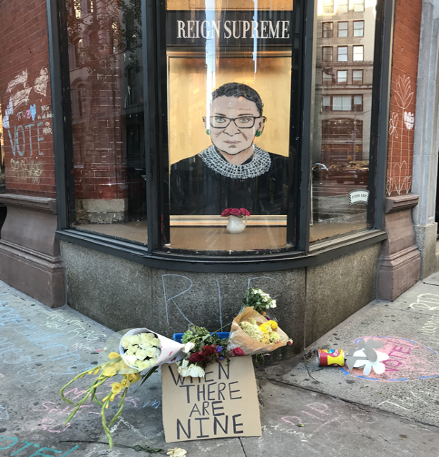The world continues to endure the devastating loss of Supreme Court Justice, Ruth Bader Ginsburg, also known as Notorious RBG. She passed away on September 18, 2020 in Washington D.C, at 87 years old due to complications of metastatic pancreas cancer. Although she is gone, her legacy continues to live on.
Ruth Bader Gisburg, a Brooklynite was born on March 15, 1933 and raised in the working-class Jewish neighborhood of Midwood. As she attended James Madison High School and focused diligently on her studies, her mother Celia Bader, struggled with cancer. Her mother influenced her by being selfless, teaching her the value of a good education and the importance of being independent. They had a close relationship and Ginsburg knew of her mother sacrificing her college education to work in a garment factory, to pay for her brother’s education at Cornell University. Celia Bader decided that her daughter Joan Ruth Bader [Ginsburg], would go further educationally than she did by secretly stashing a college fund. Although Ginsburg’s mother passed away the day before her high school graduation, the loss of her mother made her work harder to reach her goals.
Education
Before Celia Bader passed away, she was able to save $8,000 equivalent to $86,000 today. However, Ginsburg didn’t need the money since she received a scholarship to Cornell University, the same University her uncle attended. She graduated first in her class in 1954, and married her husband Martin D. Ginsburg who was already a Harvard law student. Neither one believed that by getting married their aspirations had to diminish and both ended up at the same law school. Upon entering Harvard Law School Ginsburg learned to balance being a mother and law student. Not only did she have to balance these two roles, but she also encountered the hostile environment. There were nine females (including Ginsburg) in the class of 500 students — extremely male-dominated. The females were constantly scolded by Deans, and heard “How do you justify taking a spot from a qualified man?” However, this didn’t stop Ruth Bader Ginsburg and motivated her to strive for excellence, becoming the first female on the Harvard Law Review, a prestigious law journal.
Ginsburg transferred from Harvard Law School to Columbia Law School, due to her husband getting a job in New York City. Once again she graduated first in her class in 1959, and also served on the Columbia Law Review. Even though Ginsburg had a letter of recommendation from a Harvard Law School Dean, she encountered gender discrimination upon seeking employment as a clerk for a Supreme Court Justice. She continued to search and took a clerkship with a judge at the New York District Court.
Trailblazer in Law: Women and Human Rights
Enduring gender discrimination throughout her time in law school and while seeking employment, Ginsburg founded Women’s Rights Law Reporter in 1970, in New York City and it later moved to Rutgers Law School in 1972. She also served as the first-ever faculty advisor with The Reporter, which is the oldest law journal focused on women’s rights. Additionally, she was a law professor at Rutgers Law School (1963-1972) and Columbia Law School (1972-1980), and was the first woman to receive tenure from Columbia.
Ginsburg co-founded the ACLU Women’s Rights Project to protect employees from discrimination against their employeers. Pegnancy discrimination became recognized as a form of sex discrimination, and became acknowledged as unlawful with the Pregnancy Discrimination Act — passed in 1978. This protects women against not being considered for a job/position or getting fired, if they are planning to get pregnant or are pregnant. This also includes the case of Reed v. Reed, an equal protection case, that was taken to the Supreme Court in 1971. It overturned an Idaho law that gave fathers priority over mothers because of sex, when administering a deceased child’s estates, which violated the 14th Amendment (Equal Protection Clause) and ruled unconstitutional. Additionally, it was ruled that administrators of estates can’t be named in forms that discriminate between sexes in the case.
Ruth Bader Ginsburg fought for equal rights, for both men and women alike. She represented Charles Mortiz, who had been taking care of his mother and claimed a tax deduction. However, the IRS denied the tax deduction because he was an unmarried man. Once again this violated the Equal Protection Clause and the IRS code in 1971 (section 214), which was amended in order for any individual, regardless of sex to claim caregiving deductions.
We all know Ginsburg’s famous quote: “Women belong in all places where decisions are being made. It shouldn’t be that women are the exception.” She fought for the requirement of women on juries. Up until the year of 1979, women had an option of whether they wanted to serve on juries. However, Ginsburg argued that women’s civic duty should be valued the same as men’s. She made it a requirement for women to be on every jury and that women should not be the exception.
The Impact of a Warrior
Many of us will forever look up to Ruth Bader Ginsburg as a role model. Someone who’s inspirational and didn’t let adversity stop her. When the news spread of her passing, you bet many tears were shed. I can speak for many that although we didn’t have the opportunity to meet her, it felt like we did.
Throughout her years as a Supreme Court Justice, she made sure to use her vote to support Americans in same sex marriage and abortion. Additionally, because of the legal precedents she made in the 1970s, in a way it helped establish the way households operate today. For example female breadwinners are much more common today than it was years ago. She displayed for women, it’s possible to have a career and family and not to automatically create a breadwinner-homemaker dynamic at home. A woman has a choice to either go to work, or be a homemaker. Whatever the choice…it’s a choice.
Her written dissents are [insert chef’s kiss] must read, as she addressed things most had in mind during decisions. Ginsburg also had her opinion out in the open even before she said a word; she didn’t even need to say a word. Each one of her neck pieces included a message, like the one she wore after Trump’s election — in which it expressed her dissent.
RBG: “This is my dissenting collar… It looks fitting for dissents.”
RBG: “This is my dissenting collar… It looks fitting for dissents.” pic.twitter.com/luNmrN4BCX
— Irin Carmon (@irin) July 31, 2014
Being born in Brooklyn like the late rapper Notorious B.I.G. – she gained the well-known nickname of Notorious R.B.G. An NYU law student Shana Knizhnik, created a Tumblr blog to honor Ginsburg and named it that. It later became a book “The Notorious R.B.G.” including her life as a feminist and cultural icon to legal career. She opened many (emphasis on many) doors for women. We still have work to do, so let’s get it done! Also, go vote and tell them Ruth sent you.

“When I’m sometimes asked ‘When will there be enough [women on the Supreme Court]?’ and my answer is: ‘When there are nine.’ People are shocked. But there’d been nine men, and nobody’s ever raised a question about that.”




